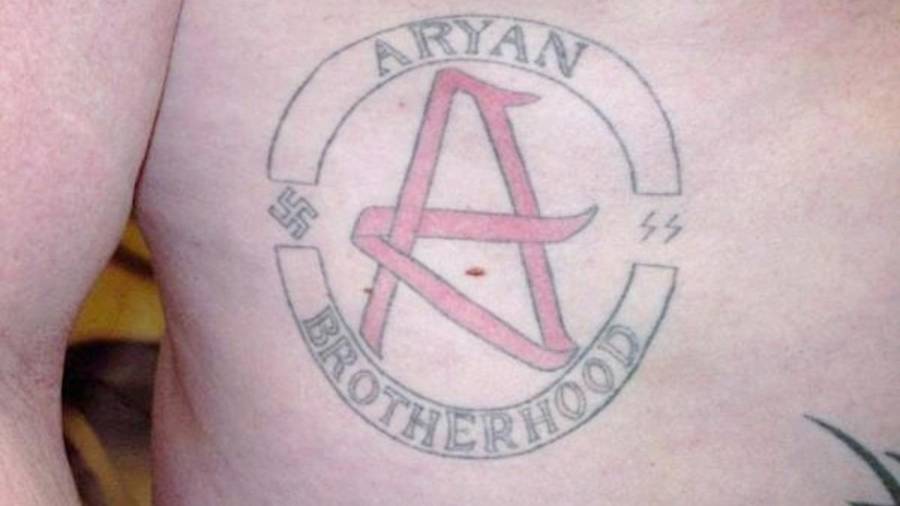Identity politics can lead to some truly violent outcomes. Case in point: the Aryan Brotherhood.
The 1950s and 60s Civil Rights movement brought about sweeping changes — including some in prisons. Desegregation extended behind bars as well, and as inmates of all races started mixing on the yards and in the showers, the violence got to be more than prison guards could control.
In self-defense, prisoners began forming racially exclusive gangs that still occupy every prison block in the country to this day.

Wikimedia Commons
One gang, the Bluebirds, exclusively comprised white inmates with some Irish ancestry. At some point during the mid-1960s, as the violence and illegal smuggling operations picked up inside prisons, the Bluebirds joined forces with a few other gangs and forged a new organization: the Aryan Brotherhood.
Blood In, Blood Out

Twitter/Aryan Brotherhood
The Aryan Brotherhood started out very differently from other prison gangs. Unlike the Black Guerrilla Family or the Nuestra Familia, which are “racist” in the sense that their membership happens to draw from a single racial group, the Aryan Brotherhood was explicitly racist from its inception and drilled white supremacist ideology into all new recruits (called “progeny”).
The group’s constitution, which members are supposed to memorize and only write out for new members to memorize, explicitly calls for exclusive loyalty and respect on the basis of a shared white heritage.
For the first 10 years of its existence, the gang took this blood oath very seriously and kept its members far away from other races. AB, as it is sometimes known, was so serious about race and ethnicity in the early days that members would sometimes turn white prospects away if they weren’t at least part Irish.
To this day, though admission standards have somewhat relaxed, members still frequently sport a shamrock tattoo as a nod to this early exclusivity.
Of course, as any veteran politician could tell you, ideology has a way of hopping out the window when there’s good money to be made. By 1975, the Aryan Brotherhood had drifted away from a tight cadre of fighting Irish in the San Quentin yard and toward a sprawling community of inmates all over the country.
With this expansion came opportunities that a simple self-defense organization could never exploit. By forming an alliance with the Mexican Mafia, AB found itself in a position to ship loads of drugs into prison and carry out loads more cash for laundering on the outside.
New Opportunities For The Aryan Brotherhood

Twitter/Aryan Brotherhood
This enlargement and diversification brought major structural changes to the Aryan Brotherhood. For nearly 20 years, the gang had operated as a direct democracy: Each brother got one vote and members brought every important issue before the full assembly of men who weren’t currently locked up in solitary confinement.
This system, which had worked fine when the group had a few dozen members in the same facility, proved unworkable by the early 1980s when paroled members who kept working after their release had organized branches in every state.
To better manage the flow of money and drugs, as well as to better direct the beatings and murders that have made AB the terror of America’s prisons, some reorganization was needed.
By around 1985, the Aryan Brotherhood had taken on its current organization. Briefly, the gang is split into two largely independent wings: One centered on California’s prisons, the other on the federal system.
Nobody who wants to live can tell just how close the two groups are, and it’s possible they operate as a single unit for most purposes, but it’s also possible they’re two mirrored versions of the same gang who hold separate franchises.
However the system works on a large scale; both factions have an identical internal structure: Paramilitary, with presidents, vice-presidents, majors, captains, and lieutenants.
Today, the Brotherhood resolves important matters via a standing council of 12 senior members, rather than a popular vote. These men don’t last long, with several being remanded to life in solitary confinement or death row, which means the line to the top levels moves quickly.
Prison Discipline

YouTubeA victim of the Aryan Brotherhood.
This new structure made an already-dangerous gang even more dangerous. From its first days, AB distinguished itself by the extreme brutality of its attacks and the complete lack of tolerance it showed to disloyalty, disrespect, or to potential threats from outside.
In prison, an elaborate etiquette exists to keep personal tensions as low as possible. Bumping into another inmate in the chow line, for example, could be the start of a major vendetta. Whenever this happens, the only way to calm things down is to immediately look the other inmate in the eyes and sincerely apologize so he knows it really was an accident. Otherwise, trouble looms.
With the Aryan Brotherhood, that trouble comes in the form of a blanket tossed over the head and hundreds of stab wounds to the kidneys. Even in the 1960s, when AB had a few dozen members, they got a reputation for meeting the slightest insult with a full-force murder, sometimes done right on the yard as a warning to others.
The gang’s “blood-in, blood-out” policy necessitates that new members kill or severely injure rival gang members or prison staff before they earn full membership. Given that there may now be up to 20,000 members of the gang — a number that, if true, would put AB close to FARC or ISIS in terms of membership — that’s a lot of assaults.
“A Vicious, Brutal Killing”

YouTube
Former Aryan Brotherhood commissioner John Greschner summed up AB’s policy toward prison murders in a 2012 interview he gave to Intelligence Report:
“For the Aryan Brotherhood, murder is a way to make a social statement. If blacks attack whites, we send a message. We go pick one of their shot callers. We catch them walking across the yard under guard escort in handcuffs. It don’t matter. We’re going to butcher him in front of God and everybody at high noon in the middle of the yard. And it’s not just going to be a few clean stab marks. It’s going to be a vicious, brutal killing. Because that’s how brothers take care of business, and a brother’s work is never done.”
The fate of inmate Neil Baumgarten was typical of the brothers’ schedule. In November 1982, Baumgarten made a deal with Brotherhood members to buy some drugs on credit. His collateral was about $1,000 of incoming cocaine for which he had already paid and which he expected to arrive before the end of the month.
Unfortunately for him, staff at the Lewisburg, Pennsylvania facility where he resided chose that week to stage a series of shakedowns across C-block, where he and his dealers lived.
Not only did the raids sabotage Baumgarten’s elaborate network of loans, the tighter security temporarily blocked the import of his cocaine. Baumgarten’s loans seem to have come due on December 9, when a guard heard screaming on the second tier of the block.
A still-breathing Baumgarten lay sprawled across the stairs, nearly naked and swimming in blood from scores of jagged wounds to his torso. According to the FBI, which investigated the incident, Baumgarten was pronounced dead on arrival at the hospital to which he was airlifted.
The Most Isolated Man In America

Wikimedia CommonsThomas Silverstein.
Baumgarten was just one of thousands of people who ran afoul of the Aryan Brotherhood. The gang makes up less than one percent of the U.S. prison population but is responsible for 21 percent of the murders across the system.
What makes the Aryan Brotherhood’s attacks so terrifying is the seeming lack of regard members show for their own safety. Members who are assigned a target generally have no problem leaping on the victim in front of witnesses and committing crimes they know will get them the harshest sentences imaginable.
A little over a year after the Baumgarten murder, an incident took place at the super high-security facility at Marion, Illinois, that perfectly illustrates both the recklessness of AB and the apparent futility of the system’s attempts to control it.
On October 22, 1983, an AB commissioner named Thomas Silverstein took revenge on a guard he later claimed had abused him. While the guard, Merle Clutts, walked Silverstein along a corridor, another prisoner distracted Clutts for a few seconds.
During that brief window, Silverstein leaned over to another inmate’s cell and slipped his shackled hands through the bars. The inmate quickly picked Silverstein’s cuffs and slipped a shiv into his hands. A few steps down the corridor, Silverstein pounced on Clutts and hacked him to death. A few hours later, another ranking Aryan Brotherhood member killed a second guard using the same trick.
These murders shook the system to its core. The Marion facility was supposed to be the most secure prison in the country. That a prison gang managed to kill two guards in four hours and that it had obviously been part of a much larger conspiracy, drove everybody in authority around the bend.
The Marion facility immediately went under “indefinite lockdown,” with prisoners held in the most extreme confinement possible. Prior lockdowns had lasted for days or weeks; this one lasted for 23 years.
Silverstein was eventually shipped to the federal supermax facility ADX Florence in Colorado. This forbidding prison is built on top of a mountain and surrounded by miles of howling wilderness.
Deep inside the facility, Silverstein is one of two inmates held under maximum “no human contact” confinement. For the last 11 years (and counting), Silverstein has been locked for 23 hours a day in a solid-walled room the size of a king-size bed. During his one hour of “recreation,” he is allowed into a small, barren courtyard with nothing in it. The lights are never turned off.
An officer at the Bureau of Prisons admitted that the harshness of this punishment was meant to deter others who might try to kill guards.
If that’s true, it isn’t working. The Aryan Brotherhood remains as strong and as violent as it ever has been. Guards at every prison in America have to watch their backs in case they run afoul of a commissioner, as do the shot callers of every other gang in the prisons AB haunts.
For the foreseeable future, the Aryan Brotherhood will remain a threat inside prison walls and a presence outside as well.
To learn more about those who have garnered millions through crime, check out this list of the most infamous living gangsters. Then, step inside the five worst prisons on the planet.





